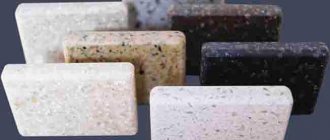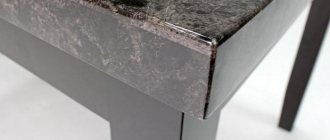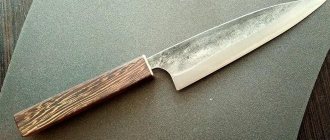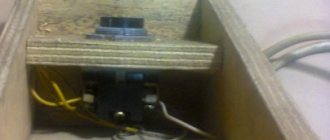Marble, which has excellent decorative properties, has always been valued in construction. But due to the high cost of the material, not everyone can afford to use it to decorate premises. Therefore, an artificial material imitating stone was developed as an alternative. It was called artificial marble.
Description and types of material
Artificial marble is a decorative and building material that quite accurately imitates natural stone. It is widely used in construction, renovation and industrial applications.
For its production, both mineral components and synthetic resins and other additives are used. Due to the special method of introducing dyes, the surface of the finished product has a characteristic pattern with marble stains and specks.
Artificial marble has many positive characteristics:
- high mechanical strength;
- durability, long period of operation;
- low thermal and electrical conductivity;
- fire safety;
- environmental friendliness, harmlessness;
- resistance to acids, alkalis, fats, moisture;
- aesthetic appearance;
- hardness, ease of processing.
Depending on the production method, artificial marble can be cast, cast, ground or liquid.
Liteva
This composite material is the most popular, since the injection molding method is applicable even at home. The basis of artificial marble is a mineral filler (quartz sand or stone chips) and polyester resin. In industry, plasticizers and other targeted additives are also added to the composition.
Oselkovy
The material is a marble-painted gypsum mass, which is diluted with an adhesive solution. Substances that slow down the setting of gypsum must be added to the composition. Due to grinding and polishing, products made from ashlar marble have a beautiful shine. They turn out durable and lightweight.
Oselok marble slabs
Important! Products made from oselkov marble do not tolerate high humidity.
Ground (microcalcite)
Crushed (ground) marble is a white, grayish powdery material obtained by grinding marble chips. It is used for the production of paints and varnishes, linoleum, and various types of plastic. Finished products are durable and resistant to UV radiation, but their moisture resistance is quite low.
Liquid
The material is produced by combining marble chips and acrylic polymers. It is lightweight, flexible, completely non-toxic and environmentally friendly. Due to their small thickness, sheets of liquid artificial marble can be cut with scissors and used instead of wallpaper. The surface will be smooth, seamless and durable.
Comparison with natural stone
Over thousands of years of use, natural marble has naturally shown its good and bad qualities. Artificial stone is used much less, but this period is enough for its advantages and disadvantages to be identified. You can compare these materials based on their main properties and characteristics:
- Environmental friendliness. Undoubtedly, natural stone outperforms artificial materials in this characteristic. However, manufacturers claim that all components of any type of artificial marble are safe for health, and very often special coatings are applied to these materials to prevent the release of any substances.
- Strength. It is easy to scratch natural marble with a simple knife. Artificial analogues can be made so strong that the knife will sooner become dull than a scratch will appear on the surface. In addition, damage to such surfaces can be easily repaired.
- Heat transfer ability (frost resistance and heat resistance). According to these parameters, both types of stone show excellent characteristics; they can be used both for cladding the outside of buildings and for use, for example, in finishing fireplaces. There will be no destruction of materials either from frost or from flame.
- Price. According to this indicator, artificial stone unconditionally outperforms natural marble.
- Water resistance. Natural marble can be of different grain sizes and densities; loose marble is not recommended for finishing rooms where it may be exposed to water (bathrooms, toilets, swimming pools, etc.). When making artificial stone, it is enough to take care of the presence of appropriate additives in the composition, or cover it with water repellents.
- Acid resistance. Natural marble is susceptible to the influence of various acids, including those found in some household chemicals, especially artificial ones. And if hydrochloric acid gets on it, a violent reaction generally occurs.
Production of cast artificial marble
Before starting work, you need to immediately prepare all materials and consumables, as well as buy or rent tools and equipment for marble production.
Equipment
First of all, you need matrices - forms for pouring the marble mixture. Polyurethane molds have proven themselves best - they are very durable and do not deform, although they are not cheap.
Table top mold
You will also need:
- components for mixing the composition;
- construction mixer;
- Sander;
- capacity;
- gelcoat sprayer or mold brushes.
Composition of raw materials
The main components are polyester resin (gelcoat) and marble chips (flour) in a 4:1 ratio. Cement, gypsum, lime, and quartz sand are also used to improve strength and improve performance characteristics.
Important! If desired, cement can completely replace the polyester resin in the composition, but the reliability of the finished marble will decrease.
In this case, the “recipe” for the solution will be as follows:
- sand – 2 parts;
- cement – 1 part;
- small stone chips – 25% of the total volume;
- water – 0.2 parts;
- plasticizer – 1% by weight of cement;
- pigment – 1% by weight of cement.
Successful examples in the interior
When installing a bathtub made of cast marble, a harmonious combination of the external finish of the tank and the walls of the room is ensured. For example, an ornament is applied to the outer part of the York series product from Victoria Albert; the supports are covered with a light-colored screen. The owner of an apartment or house can independently change the design using original pearlescent paints and a stencil. The floors and walls are covered with tiles, grouted with mastic, the color of which matches the shade of the decorative pattern on the side of the bathtub.
A rectangular bathtub can be installed along a wall or in a corner of the room; the opening is covered with a screen with mosaic tiles. The color of the finish matches the shades of the tiles on the floor and walls of the room. The mixer with shower head is built into the partition. A guide frame with matte impact-resistant steles is attached along the perimeter of the bathtub, protecting the room from the effects of splashing water.
A bathtub with massage nozzles can be installed in a special niche made of brick or gas silicate blocks covered with tiles or mosaics. On the front part there is a step lined with tiles with ornaments. Shelves are provided at the ends of the container for installing decorative elements or storing accessories. The mixer and control panel for the massage unit are built into the far side of the bathtub, and an arch with stained glass is placed on the wall of the room. There are additional shelves for accessories under the glazing.
Production technology
The method of producing artificial marble is simple, it is only important to follow the specified recommendations.
Preparation of the solution
Pour the dry ingredients into a clean container, mix them thoroughly with a mixer and add the dye. The latter is mixed in carefully to maintain the uneven color of the finished material.
Then the mass is diluted with water, shaken well or placed on a vibrating table - this will help get rid of air bubbles. Water is introduced in 2 steps: first, 80% of the liquid is added, then the plasticizer is added, and then the remaining water.
Preparation and filling of forms
The molds are placed in a strictly horizontal position, sprayed with gelcoat (polyester resin), and the solution is poured. Shake to get rid of excess air and leave to harden for at least a day under the film.
Advice! To enhance the strength of marble, reinforcement is made - a wire mesh is placed in the thickness of the solution.
Processing of finished slabs
After curing, the molds are turned over, the stone slabs are taken out and sanding begins. Such products can only be cut with equipment equipped with diamond blades.
Business organization
Organizing a business for the production of artificial marble, in principle, is no different from opening any other enterprise, and includes the following main stages:
| Stage name | Condition to be fulfilled | Deadline |
| Business registration, preparation of necessary documents | availability of a package of necessary documents | 1 month |
| Selection and arrangement of premises | 1 month | |
| Purchase and installation of necessary equipment | availability of funds | 1 month |
| Manufacturing process | fulfillment of previous conditions | throughout the entire working period |
| Implementation of marketing policy | throughout the entire working period |
We recommend reading:
- Lego brick production
- production of paving slabs
- production of expanded clay blocks
- production of arbolite blocks
- production of dry construction mixtures
Necessary equipment
All the necessary tools and equipment for making marble with your own hands can be purchased at any hardware store. You will have to specially order only molds for marble. You will need:
- polyurethane molds;
- polyethylene film for covering products;
- concrete mixer;
- vibrating table;
- brush;
- shovels;
- measuring devices and scales for precise dosage of plasticizer and coloring pigments;
- angle grinder (“grinder”);
- special cutting wheels for grinders for working with stone;
- grinding attachments.
For small production volumes, you can reduce costs by dispensing with a mixer. You can make a vibrating table yourself, reducing its cost three times compared to the price tag in the store. Consumables include:
- construction wax and gelcoat;
- sand;
- cement;
- pebbles or crushed stone;
- plasticizer;
- coloring matter.
Manufacturing facility
Installing all the necessary equipment will not take up much space. It is quite possible to use an ordinary garage as a production facility. What other business ideas can be implemented in a garage can be found at this link. However, you will also need a place for drying and storing the finished material.
Staff
The entire production process can be completed by just one person, but it is still better to work together. It is not at all necessary to hire a hired employee for this. It is advisable to organize an enterprise for the production of artificial marble with the help of one family. Additional labor will be needed only as a result of business expansion - after its promotion and the appearance of a large number of orders.
Business registration
Registering a business is possible both as an LLC and as an individual entrepreneur - there is no fundamental difference here. Therefore, the main criterion when determining the form of doing business will be the choice of the most favorable tax regime.
More information about choosing a tax payment system can be found here. All the necessary information about what taxes an individual entrepreneur pays is in this source. In addition to the standard package of documents to register your business, you will need to obtain a certificate of conformity for your products and a conclusion from Rospotrebnadzor on their quality and safety for the consumer.
We recommend reading:
- business for the production of laminated veneer lumber –
- production of fiberglass reinforcement –
- production of plastic pipes –
Use and care instructions
Artificial marble is often used for decorating rooms and wall cladding. It makes beautiful tabletops, window sills, stairs, sculptures, and decorative fountains. The material is suitable for finishing house facades, emphasizing window and door openings, and creating paving slabs.
Artificial marble should be cleaned with a soft cloth, as hard brushes can leave scratches on it. It is washed using liquid SMS and does not use drying oil-based products for polishing. Otherwise, the material is considered quite unpretentious and, with the right approach, will last for many years.
Making gypsum stone
In the production of decorative stone materials, building gypsum is often used. A mixture is prepared from it, the consistency of which should be similar to thick sour cream. When mixing, a pigment of the required color is also used.
The prepared mixture is poured into a silicone mold only up to half its height. The matrix is pre-lubricated with grease. Then a fine metal mesh is laid to enhance the strength of the stone. The mold is then filled to the brim with a mixture that lacks pigment.
The filled matrix is shaken several times so that the gypsum mixture is evenly distributed in the mold. If the curing process occurs quickly, then milk is used during mixing. It reduces the speed of setting of the mixture.
Preliminary stage
Without preliminary preparation of the surface, it is impossible to finish the walls efficiently; this stage of work must be carried out especially carefully. The main condition for simulating the selected texture is that the plane upon completion of preparation must be smooth and clean. First of all, get rid of the old putty. After this, the walls must be degreased. All existing defects in the form of cracks and irregularities are eliminated. The cracks are most often sealed with plaster.
To imitate a marble texture, a sand-cement mixture, unlike gypsum, requires more time to dry. In this case, work can be continued only after a few days. It is advisable that the room temperature at this time be at +20ºC.
How to properly prepare the surface
To apply a layer of Venetian, a perfectly flat surface is required.
Therefore, it is necessary to carefully prepare it first - level it using ordinary plaster and putty, sand it, and prime it.
Despite the high strength of the finished layer of Venetian plaster, if the base is of poor quality, cracks may appear after a few years.
To avoid this, it is necessary to ensure the stability of the surface in advance and, if necessary, use reinforcing materials.
Before applying decorative plaster, make sure the wall is perfectly flat
The best base is considered to be finishing the walls with plasterboard. They have perfectly flat surfaces, are fixed to frames and are relatively resistant to deformations that may occur in load-bearing structures. Walls of panel houses and monolithic partitions are suitable.
But stone and brickwork are most susceptible to deformation during the operation of the building, so they must be strengthened with reinforcing materials.
It is important to apply a layer of Venetian putty very thin, about 1 mm. Therefore, all the smallest irregularities must be corrected in advance. For this, after reinforcing and plastering the walls, gypsum putty is additionally used.
When preparing the base, you must also take into account its ability to absorb moisture. This applies to cement and lime plaster. In these cases, it is necessary to use primers that penetrate deeply into the plaster layer.
Painting work
Walls can be painted using brushes or rollers. Using paints you can create a variety of designs and patterns.
To imitate marble you need paint of 3 different colors. One shade will become the background. The color of this paint is selected taking into account the predominance of which shade should be obtained. It is recommended to buy paint with a glossy, semi-gloss or semi-matte sheen. But the base background should always be the darkest shade. To obtain a lighter background, apply white paint or a material with a small amount of impurities of other colors.
Walls with a combination of yellowish-white, light gray, and yellow-brown shades will look great. For example, to imitate the popular green marble, dark green, gray-green and black paint are used. The most difficult part is creating the veins that are a feature of marble. They are made with paints of colors close to white.
If necessary, you can use shades of light green and light gray. These colors are more contrasting. You should adhere to the principle that 2 additional colors should be close in shade, and one color should act as a contrast.
The process of applying plaster with your own hands
The main feature of applying marble putty is that this type of work is performed only by hand. If you need to apply putty over large areas, you can mechanize the process. When using 2 shades of putty, first apply a light mixture to the surface with a wide spatula in small strokes in different directions, wait until the coating dries completely.
Then the wall is sanded and the resulting dust is removed with a brush. Only after this is it possible to use a second shade of putty. It is applied at an angle of 30º and also in different directions. The randomness of application creates the desired effect of a marble surface. Then you need to wait until it dries completely and clean it. At the final stage, the last white layer is applied to the surface, through which the darker layers appear.
To preserve the imitation of marble texture, the wall is coated with varnish or special wax. Additionally, the surface acquires a glossy shine, which creates a stone effect. Experts do not recommend using varnish indoors; it is applied only to facades. Inside buildings, only wax is used to imitate marble, because... varnish contains toxins that are harmful to humans in confined spaces.
To imitate marble, it is most convenient to use Venetian plaster. It is sold in buckets ready for application to walls. Creating a marble texture from it takes very little time and has a number of features. 2 or 3 shades of the mixture are applied to the spatula at once. You can mix them up a little.
The amount of material should be small, sufficient for one movement of the tool along the surface. The putty is applied in one direction, slightly moving the tool from side to side, which should be done with slight pressure. This is necessary so that the layer of plaster is as thin as possible, and the main shade of the wall is slightly transparent.
If, when forming a marble pattern, only wide stripes are obtained, then you need to add thin stripes of white or black.
To do this, do the same, only apply smaller amounts of Venetian plaster of different shades to the instrument and add a pattern of a second layer of finishing. Very fine veins and cracks are applied with a brush; if necessary, acrylic paint is used.











